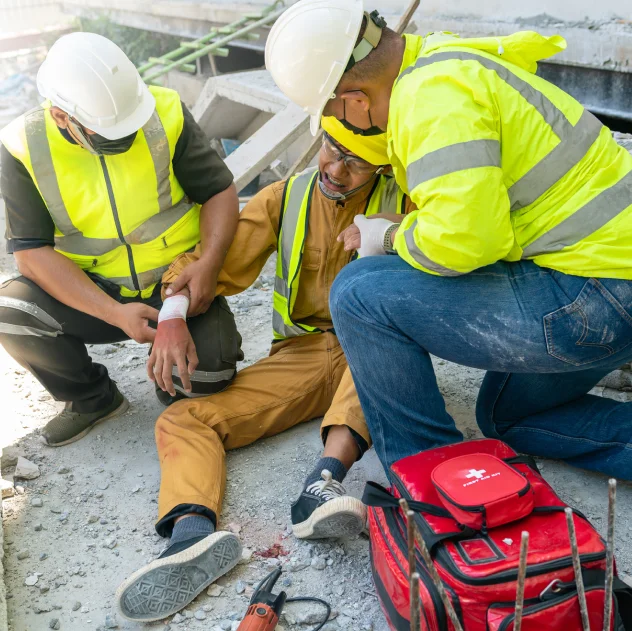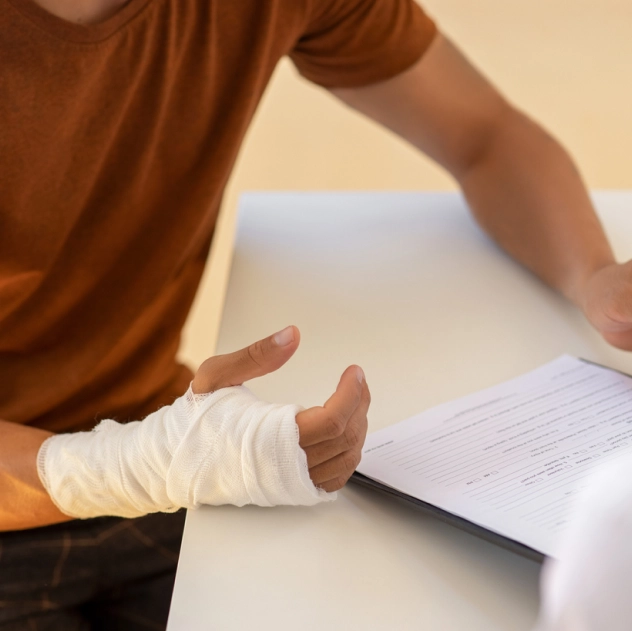Slip and fall injuries are more common than you might think. According to the CDC, slip and fall injuries accounted for approximately 18% of non-fatal work injuries that resulted in missed days at work in 2020. Sometimes these injuries are inconsequential, but others can be life altering.
If you’ve been affected by a work-related injury, you may qualify for workers’ compensation. Reach out James Koh, workers’ compensation lawyer, to discuss your legal options and learn more about how we can help you.
Common Causes of Workplace Slips, Trips, and Falls
Slips, trips, and falls are prevalent in the workplace and can occur due to various factors:
- Wet or slippery floors: Spills, leaks, or recently mopped surfaces can create hazardous conditions, especially in areas with high foot traffic.
- Uneven surfaces: Cracked or uneven flooring, loose tiles, or damaged carpeting can cause employees to trip and fall.
- Cluttered walkways: Obstacles such as boxes, cables, or equipment left in walkways can impede safe movement and increase the risk of falls.
- Inadequate lighting: Poorly lit areas make it difficult for employees to see potential hazards and navigate safely.
- Improper footwear: Wearing inappropriate footwear, such as shoes with worn-out soles or high heels, can contribute to slips and falls.
Employers must identify and address these hazards to prevent workplace accidents. This includes implementing regular maintenance procedures, providing proper signage, and ensuring employees receive training on hazard recognition and fall prevention techniques.

Common Causes of Workplace Slips, Trips, and Falls
Slips, trips, and falls are prevalent in the workplace and can occur due to various factors:
- Wet or slippery floors: Spills, leaks, or recently mopped surfaces can create hazardous conditions, especially in areas with high foot traffic.
- Uneven surfaces: Cracked or uneven flooring, loose tiles, or damaged carpeting can cause employees to trip and fall.
- Cluttered walkways: Obstacles such as boxes, cables, or equipment left in walkways can impede safe movement and increase the risk of falls.
- Inadequate lighting: Poorly lit areas make it difficult for employees to see potential hazards and navigate safely.
- Improper footwear: Wearing inappropriate footwear, such as shoes with worn-out soles or high heels, can contribute to slips and falls.
Employers must identify and address these hazards to prevent workplace accidents. This includes implementing regular maintenance procedures, providing proper signage, and ensuring employees receive training on hazard recognition and fall prevention techniques.
Common Injuries Resulting From a Slip and Fall Accident
Slip and fall accidents can lead to a wide range of injuries, including:
- Sprains and strains: Twisting or overextending joints during a fall can result in sprained ligaments or strained muscles.
- Fractures: Falls from height or impact with hard surfaces can cause broken bones, such as wrist fractures or hip fractures.
- Contusions and lacerations: Impact with objects or surfaces can result in bruises, cuts, or abrasions.
- Head injuries: Falls can cause traumatic brain injuries, ranging from concussions to more severe forms of brain damage.
- Spinal cord injuries: Severe falls may result in damage to the spinal cord, leading to paralysis or other neurological impairments.
The severity of these injuries can vary depending on factors such as the height of the fall, the surface struck, and the age and health of the individual. Prompt medical evaluation and treatment are essential to prevent complications and promote recovery.

What to Do if You Have Been Injured in a Workplace Slip and Fall
If you’ve been injured in a workplace slip and fall accident, follow these steps to protect your health and legal rights:
- Report the accident to your supervisor or employer immediately, ensuring it is documented in writing.
- Seek medical attention for your injuries, even if they appear minor at first.
- Document the details of the accident, including the cause, location, and any contributing factors.
- Gather witness statements if available to support your account of the incident.
- Keep records of all medical treatment received and follow your healthcare provider’s recommendations for recovery.
- Consult with a workers’ compensation lawyer to understand your rights and options for pursuing benefits for your slip and fall injury.
Taking these steps can help ensure you receive the necessary medical care and financial support to recover from your injuries and return to work safely.
Filing a Workers’ Comp Claim for a Slip-and-Fall Injury
Workers who suffer slip and fall injuries in the workplace may be eligible for workers’ compensation benefits.
Remember, always report the injury to your employer immediately, providing details of the accident and your injuries. Make sure that you are clear about what happened and that your workplace creates documentation about your accident. Make sure to complete any necessary paperwork required by your employer or their workers’ compensation insurance carrier.
While it may be common sense, remember to seek medical treatment for your injuries, making sure to inform healthcare providers that the injury occurred at work. Of course, this step will come first if the injury is an emergency situation.
Even if you aren’t prompted to do so by your employer, keep detailed records of all medical expenses, including bills, prescriptions, and travel costs related to treatment. Cooperate with any investigations conducted by your employer’s insurance carrier, providing accurate information about the accident and your injuries.
And finally, if your claim is denied or disputed, seek assistance from a workers’ compensation lawyer to appeal the decision and pursue the benefits you deserve.
Steps to Follow to Recover Workers’ Compensation Benefits
Filing a workers’ compensation claim in California involves several important steps to ensure your claim is processed correctly and you receive the benefits you’re entitled to. Here’s a general overview of how to file a workers’ comp claim in California:
- Report the Injury:
- Notify your employer of your injury as soon as possible, preferably immediately after it occurs or as soon as you become aware of it.
- Provide your employer with details of the accident, including the date, time, location, and how the injury occurred.
- Seek Medical Treatment:
- Obtain medical treatment for your injury from an approved healthcare provider.
- Inform the healthcare provider that your injury is work-related and provide accurate information about the circumstances of the accident.
- Complete the DWC-1 Form:
- Your employer should provide you with a workers’ compensation claim form (DWC-1) to complete. If they don’t provide it, you can download it from the California Division of Workers’ Compensation (DWC) website.
- Fill out the DWC-1 form accurately and completely, providing details about your injury, how it occurred, and any medical treatment you’ve received.
- Submit the Claim Form:
- Once you’ve completed the DWC-1 form, submit it to your employer as soon as possible.
- Keep a copy of the completed form for your records.
- Employer’s Responsibilities:
- Your employer is required to submit the DWC-1 form to their workers’ compensation insurance carrier within one working day of receiving it.
- Your employer must also provide you with a copy of the completed DWC-1 form and any other necessary paperwork related to your claim.
- Follow-Up:
- Stay in communication with your employer and their insurance carrier regarding the status of your claim.
- Provide any additional information or documentation requested by the insurance carrier in a timely manner.
- Attend Medical Evaluations:
- You may be required to attend medical evaluations arranged by the insurance carrier to assess your injury and treatment progress.
- Attend all scheduled medical appointments and follow your healthcare provider’s recommendations for treatment and rehabilitation.
- Consult with a Workers’ Compensation Attorney:
- If you encounter any difficulties with your claim, such as denials or delays in receiving benefits, consider consulting with a workers’ compensation attorney.
- An attorney can provide guidance, advocate on your behalf, and help you navigate the workers’ compensation process effectively.
By following these steps and fulfilling your responsibilities, you can ensure that your workers’ compensation claim is processed efficientl.
Frequently Asked Questions:

What are some of the common causes for slip-and-fall accidents?
Common causes for slip-and-fall accidents include wet or slippery floors, uneven surfaces, cluttered walkways, inadequate lighting, and improper footwear.
Where do most slip-and-falls happen?
Most slip-and-falls happen in areas with wet or slippery floors, such as kitchens, bathrooms, entryways, and outdoor walkways.
Who pays my medical bills from a slip-and-fall accident?
Your medical bills from a slip-and-fall accident at work are typically covered by your employer’s workers’ compensation insurance.
Can I sue for a slip-and-fall accident at work?
It will depend on the circumstances. In some cases, workers’ comp will be the exclusive remedy. However, you’ll need to consult with an attorney to be sure.
What to do after an on-the-job slip and fall?
After an on-the-job slip and fall, report the accident to your employer, seek medical attention, document the incident, and file a workers’ compensation claim.
How Can A Workers’ Comp Attorney Help You?
A workers’ compensation lawyer can provide crucial assistance if you’ve suffered a work-related injury. They offer expert legal advice about how to make the strongest claim for workers’ comp and whether you have other legal avenues to pursue. Protect your rights after an injury, and call our offices today.
Call James Koh today to discuss your legal options and learn more about how we can help you.
Contact Us
If you or a loved one have been injured in an accident, whether at work or elsewhere, contact us to handle your personal injury and workers’ compensation claims.